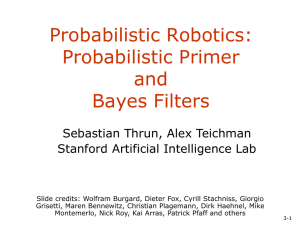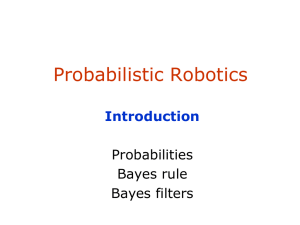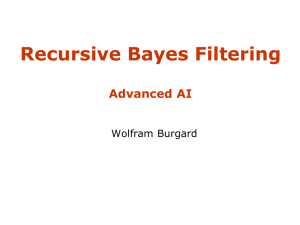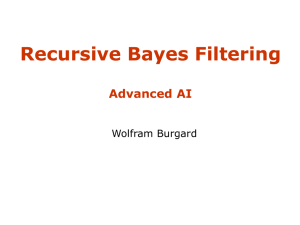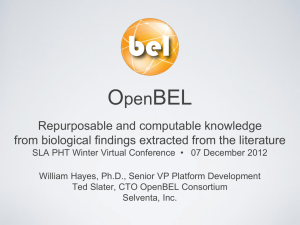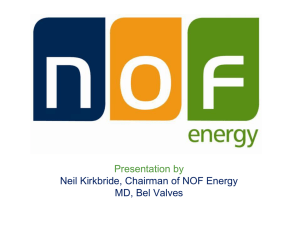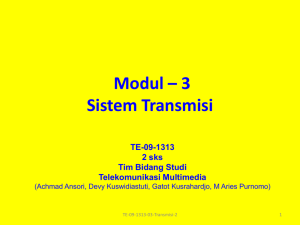Probabilistic Robotics - Faculty of Computer Science
advertisement
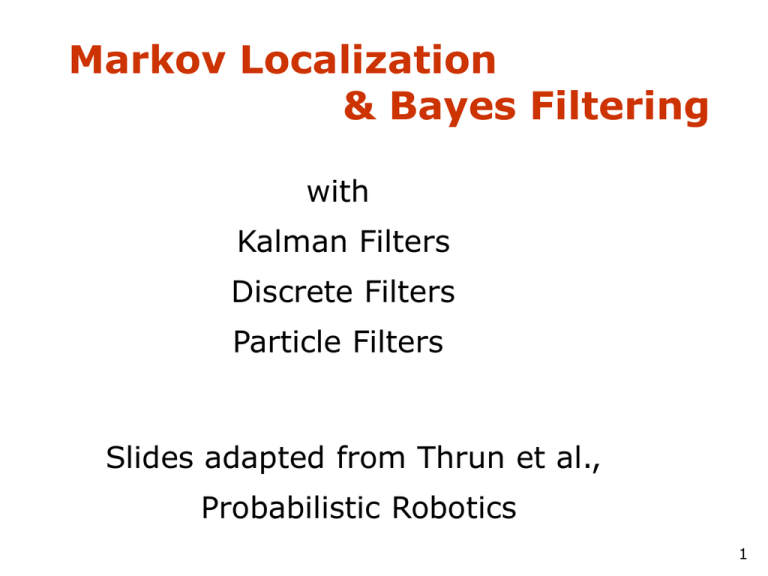
Markov Localization
& Bayes Filtering
with
Kalman Filters
Discrete Filters
Particle Filters
Slides adapted from Thrun et al.,
Probabilistic Robotics
1
Control Scheme for Autonomous
Mobile Robot
Dalhousie Fall 2011 / 2012 Academic Term
•
•
•
•
•
•
Introduction
Motion
Perception
Control
Concluding Remarks
LEGO Mindstorms
Autonomous Robotics
CSCI 6905 / Mech 6905 – Section 3
Faculties of Engineering & Computer Science
2
Control Scheme for Autonomous
Mobile Robot – the plan
•
•
•
•
•
•
Introduction
Motion
Perception
Control
Concluding Remarks
LEGO Mindstorms
– Thomas will cover generalized Bayesian filters for
localization next week
– Mae sets up the background for him, today, by
discussing motion and sensor models as well as robot
control
– Mae then follows on Bayesian filters to do a specific
example, underwater SLAM
Dalhousie Fall 2011 / 2012 Academic Term
Autonomous Robotics
CSCI 6905 / Mech 6905 – Section 3
Faculties of Engineering & Computer Science
3
Markov Localization
The robot doesn’t know where it is. Thus, a reasonable initial believe
of it’s position is a uniform distribution.
4
Markov Localization
A sensor reading is made (USE SENSOR MODEL) indicating a door at
certain locations (USE MAP). This sensor reading should be integrated
with prior believe to update our believe (USE BAYES).
5
Markov Localization
The robot is moving (USE MOTION MODEL) which adds noise.
6
Markov Localization
A new sensor reading (USE SENSOR MODEL) indicates a door at
certain locations (USE MAP). This sensor reading should be integrated
with prior believe to update our believe (USE BAYES).
7
Markov Localization
The robot is moving (USE MOTION MODEL) which adds noise. …
8
Bayes Formula
P ( x, y ) P ( x | y ) P ( y ) P ( y | x ) P ( x )
P( y | x) P ( x) likelihood prior
P( x y )
P( y )
evidence
9
Bayes Rule
with Background Knowledge
P( y | x, z ) P( x | z )
P( x | y, z )
P( y | z )
10
Normalization
P( y | x) P( x)
P( x y )
P( y | x) P( x)
P( y )
1
1
P( y )
P( y | x)P( x)
x
Algorithm:
x : aux x| y P( y | x) P( x)
1
aux x| y
x
x : P( x | y ) aux x| y
11
Recursive Bayesian Updating
P( zn | x, z1,, zn 1) P( x | z1,, zn 1)
P( x | z1,, zn)
P( zn | z1,, zn 1)
Markov assumption: zn is independent of z1,...,zn-1 if
we know x.
P( zn | x) P( x | z1,, zn 1)
P( x | z1,, zn)
P( zn | z1,, zn 1)
P( zn | x) P( x | z1,, zn 1)
1...n
P( z | x) P( x)
i
i 1...n
12
Putting oberservations and
actions together: Bayes Filters
• Given:
• Stream of observations z and action data u:
dt {u1, z1 , ut , zt }
• Sensor model P(z|x).
• Action model P(x|u,x’).
• Prior probability of the system state P(x).
• Wanted:
• Estimate of the state X of a dynamical system.
• The posterior of the state is also called Belief:
Bel( xt ) P( xt | u1 , z1 , ut , zt )
13
Graphical Representation and
Markov Assumption
p( zt | x0:t , z1:t , u1:t ) p( zt | xt )
p( xt | x1:t 1, z1:t , u1:t ) p( xt | xt 1, ut )
Underlying Assumptions
• Static world
• Independent noise
• Perfect model, no approximation errors
14
Bayes Filters
z = observation
u = action
x = state
Bel( xt ) P( xt | u1, z1 , ut , zt )
Bayes
P( zt | xt , u1, z1, , ut ) P( xt | u1, z1, , ut )
Markov
P( zt | xt ) P( xt | u1, z1, , ut )
Total prob.
P( zt | xt ) P( xt | u1 , z1 , , ut , xt 1 )
P( xt 1 | u1 , z1 , , ut ) dxt 1
Markov
P( zt | xt ) P( xt | ut , xt 1 ) P( xt 1 | u1 , z1 , , ut ) dxt 1
Markov
P ( zt | xt ) P ( xt | ut , xt 1 ) P ( xt 1 | u1 , z1 , , zt 1 ) dxt 1
P( zt | xt ) P( xt | ut , xt 1 ) Bel ( xt 1 ) dxt 1
15
•Prediction
bel ( xt ) p ( xt | ut , xt 1 ) bel ( xt 1 ) dxt 1
•Correction
bel( xt ) p( zt | xt ) bel( xt )
Bel ( xt ) Filter
P( zt | xt ) Algorithm
P( xt | ut , xt 1 ) Bel ( xt 1 ) dxt 1
Bayes
2.
Algorithm Bayes_filter( Bel(x),d ):
0
3.
If d is a perceptual data item z then
1.
4.
5.
6.
7.
8.
9.
For all x do
Bel' ( x) P( z | x) Bel( x)
Bel' ( x)
For all x do
Bel' ( x) 1Bel' ( x)
Else if d is an action data item u then
10.
11.
For all x do
12.
Return Bel’(x)
Bel ' ( x) P( x | u , x' ) Bel ( x' ) dx '
17
Bayes Filters are Familiar!
Bel ( xt ) P( zt | xt ) P( xt | ut , xt 1 ) Bel ( xt 1 ) dxt 1
• Kalman filters
• Particle filters
• Hidden Markov models
• Dynamic Bayesian networks
• Partially Observable Markov Decision
Processes (POMDPs)
18
19
Probabilistic Robotics
Bayes Filter Implementations
Gaussian filters
SA-1
Gaussians
p( x) ~ N ( , 2 ) :
1 ( x )
1
p( x)
e 2
2
Univariate
2
2
-
Linear transform of Gaussians
X ~ N ( , 2 )
2 2
Y
~
N
(
a
b
,
a
)
Y aX b
Multivariate Gaussians
X ~ N ( , )
T
Y
~
N
(
A
B
,
A
A
)
Y AX B
X 1 ~ N ( 1 , 1 )
2
1
1
1
2 ,
p( X 1 ) p( X 2 ) ~ N
1
1
X 2 ~ N ( 2 , 2 )
1 2
1 2
1 2
• We stay in the “Gaussian world” as long as we
start with Gaussians and perform only linear
transformations.
Discrete Kalman Filter
Estimates the state x of a discrete-time
controlled process that is governed by the
linear stochastic difference equation
xt At xt 1 Btut t
with a measurement
zt Ct xt t
23
Linear Gaussian Systems: Initialization
• Initial belief is normally distributed:
bel( x0 ) N x0 ; 0 , 0
24
Linear Gaussian Systems: Dynamics
• Dynamics are linear function of state and
control plus additive noise:
xt At xt 1 Btut t
p( xt | ut , xt 1) N xt ; At xt 1 Btut , Rt
bel( xt ) p( xt | ut , xt 1 )
bel( xt 1 ) dxt 1
~ N xt ; At xt 1 Bt ut , Rt ~ N xt 1 ; t 1 , t 1
25
Linear Gaussian Systems: Observations
• Observations are linear function of state
plus additive noise:
zt Ct xt t
p( zt | xt ) N zt ; Ct xt , Qt
bel( xt )
p( zt | xt )
bel( xt )
~ N zt ; Ct xt , Qt
~ N xt ; t , t
26
Kalman Filter Algorithm
1.
Algorithm Kalman_filter( t-1, t-1, ut, zt):
2.
3.
4.
Prediction:
t At t 1 Bt ut
t At t 1 AtT Rt
5.
6.
7.
8.
Correction:
Kt t CtT (Ct t CtT Qt )1
t t Kt ( zt Ct t )
t (I Kt Ct )t
9.
Return t, t
27
Kalman Filter Summary
• Highly efficient: Polynomial in
measurement dimensionality k and
state dimensionality n:
O(k2.376 + n2)
• Optimal for linear Gaussian systems!
• Most robotics systems are nonlinear!
28
Nonlinear Dynamic Systems
• Most realistic robotic problems involve
nonlinear functions
xt g (ut , xt 1 )
zt h( xt )
29
Linearity Assumption Revisited
30
Non-linear Function
31
EKF Linearization (1)
32
EKF Linearization (2)
33
EKF Linearization (3)
34
EKF Linearization: First Order
Taylor Series Expansion
• Prediction:
g (ut , t 1 )
g (ut , xt 1 ) g (ut , t 1 )
( xt 1 t 1 )
xt 1
g (ut , xt 1 ) g (ut , t 1 ) Gt ( xt 1 t 1 )
• Correction:
h( t )
h( xt ) h( t )
( xt t )
xt
h( xt ) h( t ) H t ( xt t )
35
EKF Algorithm
1. Extended_Kalman_filter( t-1, t-1, ut, zt):
2.
3.
4.
Prediction:
t g (ut , t 1 )
t At t 1 Bt ut
t Gt t 1GtT Rt
t At t 1 AtT Rt
5.
6.
7.
8.
Correction:
Kt t HtT (Ht t HtT Qt )1
t t Kt ( zt h(t ))
9.
Return t, t
t ( I Kt Ht )t
h( t )
Ht
xt
Kt t CtT (Ct t CtT Qt )1
t t Kt ( zt Ct t )
t (I Kt Ct )t
g (ut , t 1 )
Gt
xt 1
36
Localization
“Using sensory information to locate the robot
in its environment is the most fundamental
problem to providing a mobile robot with
autonomous capabilities.”
[Cox ’91]
• Given
• Map of the environment.
• Sequence of sensor measurements.
• Wanted
• Estimate of the robot’s position.
• Problem classes
• Position tracking
• Global localization
• Kidnapped robot problem (recovery)
37
Landmark-based Localization
38
EKF Summary
• Highly efficient: Polynomial in
measurement dimensionality k and
state dimensionality n:
O(k2.376 + n2)
• Not optimal!
• Can diverge if nonlinearities are large!
• Works surprisingly well even when all
assumptions are violated!
39
Kalman Filter-based System
• [Arras et al. 98]:
• Laser range-finder and vision
• High precision (<1cm accuracy)
[Courtesy of Kai Arras]
40
Multihypothesis
Tracking
41
Localization With MHT
• Belief is represented by multiple hypotheses
• Each hypothesis is tracked by a Kalman filter
• Additional problems:
• Data association: Which observation
corresponds to which hypothesis?
• Hypothesis management: When to add / delete
hypotheses?
• Huge body of literature on target tracking, motion
correspondence etc.
42
MHT: Implemented System (2)
Courtesy of P. Jensfelt and S. Kristensen
43
Probabilistic Robotics
Bayes Filter Implementations
Discrete filters
SA-1
Piecewise
Constant
45
Discrete Bayes Filter Algorithm
2.
Algorithm Discrete_Bayes_filter( Bel(x),d ):
0
3.
If d is a perceptual data item z then
1.
4.
5.
6.
7.
8.
9.
For all x do
Bel' ( x) P( z | x) Bel( x)
Bel' ( x)
For all x do
Bel' ( x) 1Bel' ( x)
Else if d is an action data item u then
10.
11.
For all x do
12.
Return Bel’(x)
Bel' ( x) P( x | u, x' ) Bel( x' )
x'
46
Grid-based Localization
47
Sonars and
Occupancy Grid Map
48
Probabilistic Robotics
Bayes Filter Implementations
Particle filters
SA-1
Sample-based Localization (sonar)
Particle Filters
Represent belief by random samples
Monte Carlo filter, Survival of the fittest,
Condensation, Bootstrap filter, Particle filter
Filtering: [Rubin, 88], [Gordon et al., 93], [Kitagawa 96]
Estimation of non-Gaussian, nonlinear processes
Computer vision: [Isard and Blake 96, 98]
Dynamic Bayesian Networks: [Kanazawa et al., 95]d
Importance Sampling
Weight samples: w = f / g
Importance Sampling with Resampling:
Landmark Detection Example
Particle Filters
Sensor Information: Importance Sampling
Bel( x) p( z | x) Bel ( x)
p( z | x) Bel ( x)
w
p ( z | x)
Bel ( x)
Robot Motion
Bel ( x)
p( x | u x' ) Bel ( x' )
,
d x'
Sensor Information: Importance Sampling
Bel( x) p( z | x) Bel ( x)
p( z | x) Bel ( x)
w
p ( z | x)
Bel ( x)
Robot Motion
Bel ( x)
p( x | u x' ) Bel ( x' )
,
d x'
Particle Filter Algorithm
1. Algorithm particle_filter( St-1, ut-1 zt):
2. St ,
0
3. For i 1 n
Generate new samples
4.
Sample index j(i) from the discrete distribution given by wt-1
5.
Sample xti from p( xt | xt 1, ut 1 ) using xtj(1i ) and ut 1
6.
wti p( zt | xti )
Compute importance weight
7.
wti
Update normalization factor
8.
St St { xti , wti }
Insert
9. For i 1 n
10.
wti wti /
Normalize weights
Particle Filter Algorithm
Bel ( xt ) p( zt | xt ) p( xt | xt 1 , ut 1 ) Bel ( xt 1 ) dxt 1
draw xit1 from Bel(xt1)
draw xit from p(xt | xit1,ut1)
Importance factor for xit:
targetdistribution
w
proposaldistribution
p( zt | xt ) p( xt | xt 1 , ut 1 ) Bel ( xt 1 )
p( xt | xt 1 , ut 1 ) Bel ( xt 1 )
p( zt | xt )
i
t
Motion Model Reminder
Start
Proximity Sensor Model Reminder
Laser sensor
Sonar sensor
Initial Distribution
63
After Incorporating Ten
Ultrasound Scans
64
After Incorporating 65
Ultrasound Scans
65
Estimated Path
66
Localization for AIBO
robots
Limitations
• The approach described so far is able
to
• track the pose of a mobile robot and to
• globally localize the robot.
• How can we deal with localization
errors (i.e., the kidnapped robot
problem)?
68
Approaches
• Randomly insert samples (the robot
can be teleported at any point in
time).
• Insert random samples proportional
to the average likelihood of the
particles (the robot has been
teleported with higher probability
when the likelihood of its observations
drops).
69
Global Localization
70
Kidnapping the Robot
71
Summary
• Particle filters are an implementation of
•
•
•
•
recursive Bayesian filtering
They represent the posterior by a set of
weighted samples.
In the context of localization, the particles
are propagated according to the motion
model.
They are then weighted according to the
likelihood of the observations.
In a re-sampling step, new particles are
drawn with a probability proportional to
the likelihood of the observation.
73
